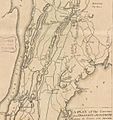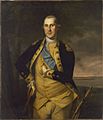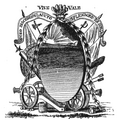William Howe, 5th Viscount Howe facts for kids
Quick facts for kids
General The Right Honourable
The Viscount Howe
|
|
|---|---|
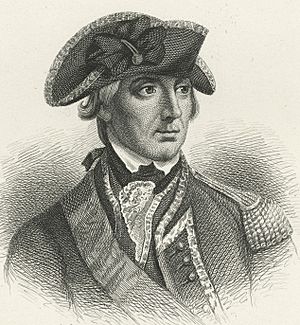
Engraving by Henry Bryan Hall
|
|
| Commander-in-Chief of British land forces | |
| In office September 1775 – May 1778 |
|
| Monarch | George III |
| Preceded by | Thomas Gage |
| Succeeded by | Henry Clinton |
| Member of Parliament for Nottingham |
|
| In office 1758–1780 Serving with Willoughby Aston (1758–1761)
Serving with John Plumptre (1761–1774) Serving with Charles Sedley (1774–1778) Serving with Abel Smith (1778–1779) Serving with Robert Smith (1779–1780) |
|
| Preceded by | George Howe |
| Succeeded by | Daniel Coke |
| Personal details | |
| Born | 10 August 1729 England |
| Died | 12 July 1814 (aged 84) Twickenham, United Kingdom |
| Resting place | Twickenham |
| Political party | Whig |
| Spouse |
Frances Connolly
(m. 1765) |
| Military service | |
| Allegiance | |
| Branch/service | |
| Years of service | 1746–1803 |
| Rank | General |
| Commands | Colonel, 60th (later 58th) Regiment of Foot Colonel, 46th Regiment of Foot Commander-in-Chief of British land forces Colonel, 19th Light Dragoons Northern District |
| Battles/wars | |
William Howe, born on August 10, 1729, was a British Army officer. He became the leader of British land forces in the American Colonies. This happened during the American War of Independence.
Howe was one of three brothers who were all successful military officers. People often called him Sir William Howe. This helped tell him apart from his brother Richard, who was a naval commander.
He joined the army in 1746. He served in the War of the Austrian Succession and the Seven Years' War. He was famous for helping capture Quebec in 1759. He led British troops up the cliffs at Anse-au-Foulon. This helped James Wolfe's army fight the French in the Battle of the Plains of Abraham. Howe also fought in campaigns to take Louisbourg, Belle Île, and Havana.
In March 1775, Howe was sent to North America. He arrived in May, after the American War of Independence had started. He led British troops to a costly win at the Battle of Bunker Hill. Then, in September 1775, he took command of all British forces in America.
Howe's time in North America included capturing New York City and Philadelphia. However, his plans for 1777 were not good. This led to John Burgoyne's Saratoga campaign failing. That failure helped France join the war. People still debate how much Howe was to blame for British problems that year.
He was made a knight after his wins in 1776. He left his role as Commander-in-Chief in 1777. He went back to England in 1778. He served in the House of Commons from 1758 to 1780. He became the 5th Viscount Howe when his brother Richard died in 1799. He had no children, so his title ended when he died in 1814.
Contents
Early Life and Military Start
William Howe was born in England on August 10, 1729. He was the third son of Emanuel Howe, 2nd Viscount Howe. His mother, Charlotte, was connected to King George I. This link to the royal family might have helped his career. But all four Howe brothers were also very skilled officers.
William's oldest brother, George Howe, was a general. He died in 1758 before the Battle of Carillon. Another brother, Richard Howe, became a top naval commander. Their father was a politician who died in Barbados in 1735.
William joined the army at 17 in 1746. He bought a junior officer's rank in the Duke of Cumberland's Dragoons. He became a lieutenant the next year. He then served in Flanders for two years during the War of the Austrian Succession. After that war, he moved to the 20th Regiment of Foot. There, he became friends with James Wolfe.
Fighting in the Seven Years' War
Howe's service during the Seven Years' War helped him become well-known. He was promoted to major in 1756. In 1757, he joined the 58th Regiment of Foot and became a lieutenant colonel.
He led his regiment at the Siege of Louisbourg in 1758. He led an attack from the sea under heavy enemy fire. This action helped the British gain a good position. General Wolfe praised Howe for his bravery.
Howe led a light infantry group under General Wolfe during the 1759 Siege of Quebec. He was part of the Battle of Beauport. Wolfe chose him to lead the climb from the Saint Lawrence River to the Plains of Abraham. This led to the British win in the Battle of the Plains of Abraham on September 13, 1759.
After defending Quebec City for the winter, his regiment fought in the Battle of Sainte-Foy in April 1760. They also took part in the siege of Quebec. He then led a group in the important Montreal Campaign under Jeffery Amherst. After this, he went back to England.
Howe led a group in the 1761 Capture of Belle Île, off the French coast. He turned down a chance to be military governor there. He wanted to keep serving in active battles. He also helped capture Havana in 1762.
In 1758, Howe was elected to Parliament for Nottingham. His mother helped him get elected while he was away at war. Serving in Parliament was a common way to help one's military career. In 1764, he became a colonel. In 1768, he was made lieutenant governor of the Isle of Wight.
As problems grew between Britain and the American colonies, Howe continued to rise in rank. He was seen as one of the best officers in the army. He became a major general in 1772. In 1774, he created new training methods for light infantry.
In Parliament, he generally supported the American colonies. He spoke against the laws meant to punish the Thirteen Colonies. These laws were called the Intolerable Acts. In 1774, he told his voters he would not fight against the Americans. He even said the whole British army could not conquer America.
However, when King George asked him to serve in early 1775, he accepted. He said he would look bad if he did not help his country. He sailed for America in March 1775. Major Generals Henry Clinton and John Burgoyne went with him.
The American Revolutionary War
Howe was first sent to Boston. He did not agree with the British government's policy towards the colonists. He was especially sad to be sent to Boston. His brother George was still remembered there. Also, he did not trust General Thomas Gage, who was the commander-in-chief.
Howe, Clinton, and Burgoyne arrived in Boston on May 25, 1775. They learned that war had begun with the Battles of Lexington and Concord in April. Howe led 4,000 troops to help the 5,000 troops under General Gage. Gage's troops were surrounded in Boston.
The generals planned to take high ground around Boston. They wanted to attack the colonial militia. They set the attack for June 18. But the colonists found out. They built forts on Breed's Hill and Bunker Hill on the night of June 16–17. This made the British change their plan.
Battle of Bunker Hill
On June 17, the generals decided to attack the colonial fort directly. Gage gave Howe command of the operation. The attack, known as the Battle of Bunker Hill, started that afternoon.
Howe personally led the right side of the attack. The first two attacks were pushed back by the colonists. Howe's third attack finally took the hill. But the cost was very high. More than 1,000 British soldiers were killed or wounded. This was the most casualties in any battle of the war. Howe called it a "success... too dearly bought."
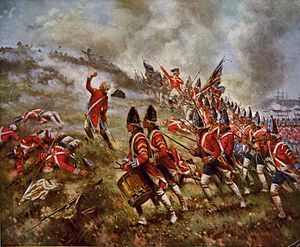
Howe was not hurt, but the battle affected him deeply. Historians say it changed his behavior. His military skills sometimes failed him when they were most needed. He seemed confident, but he often lacked self-confidence. In later campaigns, he relied on his older brother Richard for advice.
On October 11, 1775, General Gage left for England. Howe became the Commander-in-Chief of British land forces in America. British planners in London wanted to send many more troops to North America. They planned to leave Boston and set up bases in New York and Newport, Rhode Island. This was to try and stop the rebellion in New England.
Howe received these orders in November. But he chose to stay in Boston for the winter. He decided to start the campaign in 1776. So, the rest of the Siege of Boston was mostly a standstill. Howe never tried a big battle with the Continental Army. This army was now led by Major General George Washington. In January 1776, Howe was made a full general in North America.
The siege ended in March 1776. Continental Army Colonel Henry Knox brought heavy cannons from Fort Ticonderoga to Boston. General Washington used them to fortify Dorchester Heights. This hill overlooked Boston and its harbor. Howe first planned an attack on this spot. But a snowstorm stopped him. He then decided to leave Boston. On March 17, British troops and Loyalists left the city. They sailed for Halifax, Nova Scotia.
New York Campaign
Howe and his troops arrived near New York Harbour in early July. They landed on Staten Island without a fight. Howe had orders to avoid conflict until more troops arrived. He waited until mid-August for these reinforcements. His brother Richard, the naval commander, also arrived then.
This delay was costly. The Americans used the time to improve their forts on northwestern Long Island. They also got more militia for their army. Howe moved most of his army to southwestern Long Island. He attacked American positions on August 27. This became the Battle of Long Island.

Howe and Clinton led a column around the American left side. They went through the lightly guarded Jamaica Pass. This surprised the Americans. It forced them back to their forts on Brooklyn Heights. Howe decided not to attack these forts right away. He said his troops had "done handsomely enough." Instead, he started a siege. This allowed General Washington to move his army across the East River at night. A thick morning fog helped them.
Some officers, like General Clinton, criticized Howe for not storming the American forts. Howe was made a knight for his win on Long Island.
Howe and his brother Richard were also peace commissioners. They had limited power to talk with the rebels. After Long Island, they tried to make peace. They sent the captured General John Sullivan to Philadelphia with a peace offer. The meeting was not successful. The Howes had limited powers, and the Americans insisted on independence. This was not something the Howes could agree to. So, the talks failed.
Howe then continued the campaign. He landed troops on Manhattan on September 15. He occupied New York City. But his advance north was stopped the next day at Harlem Heights. He paused for almost a month. He used this time to control New York City and wait for more troops. During this time, he ordered the execution of Nathan Hale for spying.
He then tried to land on the mainland at Throgs Neck. He wanted to go around Washington's position. But the narrow path to the mainland was well-defended. He pulled his troops back. He then successfully landed troops at Pell's Point in Westchester County. But Washington managed to avoid being trapped. He retreated to White Plains.
Howe forced Washington out of the New York area in the Battle of White Plains on October 28. Then he focused on securing Manhattan for the British. In November, he attacked the remaining American fort in the Battle of Fort Washington. He took thousands of prisoners.

Washington then retreated across New Jersey. Howe's troops, led by Charles Cornwallis, followed him. Howe then prepared troops to occupy Newport. This was another main goal of his plan. General Clinton suggested landing these troops in New Jersey instead. This could trap Washington or capture Philadelphia. Howe said no to these ideas. He sent Clinton and General Hugh, Earl Percy, to take Newport.
In early December, Howe went to Trenton, New Jersey. He arranged his troops for the winter. Washington had retreated across the Delaware River. Howe went back to New York. He thought the campaign was over for the season. But Washington attacked the Hessian troops at Trenton on December 26, 1776. Howe sent Cornwallis to gather the army in New Jersey and chase Washington. Cornwallis failed. Washington won a second victory at Trenton and a third at Princeton. Howe then called the army back to positions closer to New York for the winter.
Historians have criticized Howe for not defeating the American army during the New York campaign. Some said he failed to trap Washington. But Howe's main goal was to secure Manhattan, not necessarily to destroy Washington's army. However, some historians say Howe stuck too closely to his plans. This meant he missed chances for a decisive victory.
Philadelphia Campaign
On November 30, 1776, Howe wrote to Lord George Germain about plans for 1777. He suggested sending 10,000 men up the Hudson River to capture Albany, New York. This would work with an expedition from Quebec.
He wrote again on December 20, 1776, with more detailed plans. These still included controlling the Hudson River. They also added operations from Newport and an expedition to take Philadelphia. Howe thought Philadelphia was a good target. Washington was just north of the city. Howe wrote that the main army should attack Philadelphia, "where the enemy's chief strength lies." Germain liked this plan. But it needed more men than Germain was willing to provide.
After problems in New Jersey, Howe suggested attacking Philadelphia in mid-January 1777. This plan included a land attack and a sea attack. He thought this might lead to a big win over the Continental Army. By April, Howe's army was building pontoon bridges. Washington, in his winter camp, thought they were for crossing the Delaware River. But by mid-May, Howe seemed to have given up the land attack idea. He wrote, "I propose to invade Pennsylvania by sea... we must probably abandon the Jersies."
When the campaign season began in May 1777, General Washington moved his army. They went from their winter camp to a strong position in the Watchung Mountains. In June 1777, Howe began making strange moves in New Jersey. He seemed to be trying to get Washington's army out into open ground. This would be better for a big battle.
When Washington refused to move, Howe pulled his army back to Perth Amboy. Colonel Daniel Morgan's riflemen bothered his forces as they moved. Washington moved to a more open spot, thinking Howe would put his army on ships. Howe then launched a quick attack to cut off Washington's retreat. This failed at the Battle of Short Hills. This gave Washington time to retreat to a safer spot.
Howe then did put his army on ships. He sailed south with his brother's fleet. Howe kept the fleet's destination a secret. Not only did Washington not know, but many British soldiers did not either.
Howe's campaign for Philadelphia began with a landing at Head of Elk, Maryland, in late August. This was southwest of the city. Howe would have preferred to land on the Delaware River. But reports of strong defenses stopped him. The fleet spent almost an extra month at sea to reach Head of Elk.
Howe's army left Head of Elk on September 3, 1777. They pushed back American light infantry at Cooch's Bridge. On September 11, 1777, Howe's army met Washington's near Chadds Ford. This was along the Brandywine Creek in the Battle of Brandywine. Howe again went around the American position. He forced Washington to retreat after causing many casualties.
After two weeks of movement and small battles, Howe entered Philadelphia on September 26. He had expected a warm welcome. He thought "Friends thicker than Woods" would greet him. Instead, he saw women, children, and many empty houses. Howe tried to stop his troops from misbehaving. But soldiers still caused problems. This hurt public opinion of his army.
One week after Howe entered Philadelphia, on October 4, Washington attacked the British at Germantown. He almost won the battle. But reinforcements from the city pushed him back. This made Howe move his troops closer to the city. They were also needed to clear American defenses on the Delaware River. These defenses were stopping the navy from supplying the army. This task was finished in late November. It included a poorly planned attack on Fort Mercer.
Impact on Burgoyne's Campaign
While Howe was fighting, General Burgoyne led his expedition south from Montreal. He wanted to capture Albany. Burgoyne's advance was stopped in the Battles of Saratoga in September and October. He surrendered his army on October 17.
Burgoyne's surrender, plus Howe's near-defeat at Germantown, changed the war. Support for the Continental Congress grew stronger. The victory encouraged France to join the war against Britain. Burgoyne's loss also weakened the British government.
Burgoyne thought Howe or his troops would meet him in Albany. Burgoyne did not seem to know that Howe's plans had changed. It is unclear if Germain told Burgoyne about Howe's changes. Some say he did, others say Burgoyne was not told until his campaign was well underway.
Historians debate if Howe failed to follow orders. Some say he abandoned Burgoyne's army. Others say Burgoyne failed on his own. They say he then tried to blame Howe and Clinton.
Howe's choice to focus on Philadelphia might have been due to competition with General Burgoyne. Burgoyne was given command of the northern force. Howe had wanted Clinton to have that command. Historian John Alden notes the rivalries among British leaders. He says Howe was likely jealous of Burgoyne. He did not want to help his junior officer get more fame.
Howe wrote to Burgoyne on July 17. He said he planned to stay near Washington. He wrote: "My intention is for Pennsylvania, where I expect to meet Washington, but if he goes to the northward contrary to my expectations, and you can keep him at bay, be assured I shall soon be after him to relieve you." This suggested Howe would follow Washington north if needed. But Howe sailed from New York on July 23. On August 30, Howe wrote to Germain that he could not help Burgoyne. He said there was not enough Loyalist support in Philadelphia.
A small force sent north from New York by General Clinton in early October also could not help Burgoyne.
Resignation
In October 1777, Howe sent his resignation letter to London. He complained that he had not received enough support. In April 1778, he was told his resignation was accepted.
A big party, called the "Mischianza", was held for Howe on May 18. His aides John André and Oliver De Lancey Jr. organized it. The party had a parade, fireworks, and dancing. Washington knew the British planned to leave Philadelphia. He sent the Marquis de Lafayette out with a small force to find out British movements. British troops noticed this. Howe ordered a column to trap Lafayette. In the Battle of Barren Hill, Lafayette escaped with few losses.
On May 24, the day Howe sailed for England, General Clinton took over. He became commander-in-chief of British armies in America. Clinton prepared for a land march to New York. Howe arrived back in England on July 1. He and his brother faced criticism for their actions in North America.
In 1779, Howe and his brother asked for a government review of their actions. The review could not confirm any charges against them. Because the review was not clear, attacks against Howe continued. In 1780, he published a response to accusations from Loyalist Joseph Galloway. Galloway then wrote a reply that strongly criticized Howe.
Later Life
In 1780, Howe lost his bid to be re-elected to the House of Commons. In 1782, he was named a lieutenant general. He was also appointed to the Privy Council. His command was moved to the 19th Light Dragoons in 1786.
He returned to limited active duty in 1789. This was when a problem with Spain threatened war. He was put in charge of forces for action against Spain. But the problem was solved. Howe did not see more action until 1793. This was when the French Revolutionary Wars involved Britain. He was promoted to full general in 1793. He commanded the Northern District from 1793 and the Eastern District from 1795. In 1795, he became governor of Berwick-on-Tweed.
When his brother Richard died in 1799 without male children, Howe inherited the Irish titles. He became the 5th Viscount Howe and Baron Clenawly. In 1803, he resigned as lieutenant general, saying he had poor health. In 1808, he was made governor of Plymouth. He died at Twickenham in 1814 after a long illness.
Howe married Frances Connolly in 1765. They had no children. So, his titles ended when he died. His wife lived three more years. Both are buried in Twickenham.
In Popular Culture
Howe appears in the TV show Sleepy Hollow. He is shown in flashbacks as a brilliant but cruel general. He was known by Ichabod Crane before Crane joined the American side. In the show, Howe offers Crane a chance to return to Britain. Howe also plays a role in crossover episodes between Sleepy Hollow and Bones.
Howe is also in two stories by Nathaniel Hawthorne. These are "Howe's Masquerade" and "Old Esther Dudley." They are part of Legends of the Province House, written in 1838–1839.
Images for kids
-
Depiction of the Battle of Bunker Hill by Percy Moran, 1909
-
A period map depicting the British Army movements in Westchester County, New York
-
George Washington, driven from New York beginning at the Battle of Brooklyn
portrait by Charles Wilson Peale 1776 -
Howe made the Masters-Penn mansion his headquarters during the 1777–1778 British occupation of Philadelphia. It later served as the presidential mansion of George Washington and John Adams, 1790–1800.
-
Artwork on the tickets to the Mischianza
See also
 In Spanish: William Howe para niños
In Spanish: William Howe para niños






